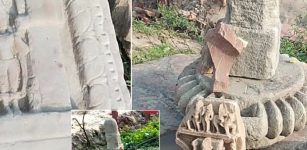Dark History Of Pömmelte, The German Stonehenge – What Can The Nebra Sky Disc And Archaeology Reveal?
Conny Waters - AncientPages.com - Pömmelte is the German version of Stonehenge. This ancient monument located in in Saxony, eastern Germany, is in many ways similar to its British counterpart. However, latest archaeological discovery reveals Pömmelte has a very dark history and the place was used in a gruesome ritualistic fashion.
Human Sacrifice Practiced At Pömmelte?
Excavating at Pömmelte, researchers have uncovered the remains of corpses buried in pits. Scientists are uncertain whether the bodies of women and children were killed during a ritual sacrifice or in a raid of the grounds, but there are reasons to suspect Pömmelte served as a place suited for human sacrifice.
Many of the victims had severely fractured skulls and ribs. Pömmelte was used from around 2,300 B.C to 2,050 B.C.
“It looks like at the end of the main occupation, around 2050 BC, they extracted the posts, put offerings into the post holes, and probably burned all the wood and back-shovelled it into the ditch,” Dr Spatzier told Live Science.
“So, they closed all the features. It was still visible above ground, but only as a shovel depression.”
According to authors of the study, the “circular or henge-like enclosures were monumental sanctuaries that served as venues for communal gatherings, ritual activities and performance.”
What Can The Nebra Sky Disc Tell Us About The German Stonehenge?
Some years ago, researchers found a curious ancient astronomical artifact known as the Nebra Sky Disc. This Bronze Age disc is believed to represent 3,600 years old astronomical knowledge.
Was the Nebra Sky Disc the first true representation of the cosmos, used for measuring astronomical phenomena or was it a tool used for shamanistic rituals?
“It’s a difficult question to answer, but I do not think it was used as an instrument used for observing objects in the sky,” said Curt Roslund, an astronomer at Gothenburg, Sweden. He argues that few features on the disc tend towards exact representation and that it is more likely to have been of symbolic value – perhaps used in shamanic rituals.
Scientists now say that the Nebra Sky Disc may shed some light on the German Stonehenge. “The Nebra sky disc is a find of global importance. Its iconography implies intensive observation of the sky and knowledge of complex astronomical. The location and context of the disc's deposition in eastern Germany provide insights into the ritual activities of political and cultic authority in the Central European Early Bronze Age.
In this region, some 2000 years before, in the early fifth millennium BC, we find the so-called Kreisgrabenanlagen. These circular enclosures, commonly 40–120m in diameter, are defined by ditches with two to four entrances. Based on their layout and the astronomical alignment of their entrances, they have been widely interpreted as sanctuaries The term Kreisgrabenanlagen is, however, misleading, as those monuments also frequently feature concentric rings of pits and posts. In recent decades, evidence has accumulated for comparable enclosures of later dates, including the Early Bronze Age Únětice Culture between 2200 and 1600 BC, and thus into the chronological and cultural context of the Nebra sky disc.
Based on the analysis of one of these enclosure sites, recently excavated at Pömmelte on the flood plain of the Elbe River near Magdeburg, Saxony-Anhalt, and dating to the late third millennium B.C,” researchers wrote in their paper.
Ancient People Wanted To Preserve The Cosmic Order
Researchers from Cambridge University also wrote in their study that ancient people appeared to have used the henge to protect the cosmic order.
“The circular enclosure of Pömmelte is the first Central European monumental complex of primarily sacred importance that has been excavated and studied in detail. It reveals aspects of society and belief during the transition from the Final Neolithic to the Early Bronze Age, in the second half of the third millennium BC. Furthermore, it offers details of ritual behaviour and the way that people organised their landscape.
A reconstruction of Germany's Pömmelte.
A sacred interior was separated from the profane environment, and served as a venue for rites that secured the continuity of the social, spiritual and cosmic order. Ancestor worship formed another integral part of this: a mound-covered burial hut and a square-shaped ditch sanctuary (located, respectively, within and near the enclosure's south-eastern sector; dating to 2880–2580 cal BC and attributed to the Corded Ware Culture that this site was deliberately chosen. With construction of the ring sanctuary, this place gained an immense expansion in meaning—comparable to Stonehenge.
See also: More Archaeology News
Through architectural transformation, both sites developed into sanctuaries with increasingly complex religious functions, including in relation to the cult of the dead. The cosmological and social functions, and the powerful symbolism of the Nebra sky disc and hoard are reflected in Pömmelte's monumental architecture.”
More scientific studies should give us a better understanding of the ancient site’s use, but based on what is known so far, it appears it was indeed a place of sacrifice.
Written by Conny Waters – AncientPages.com Staff Writer























